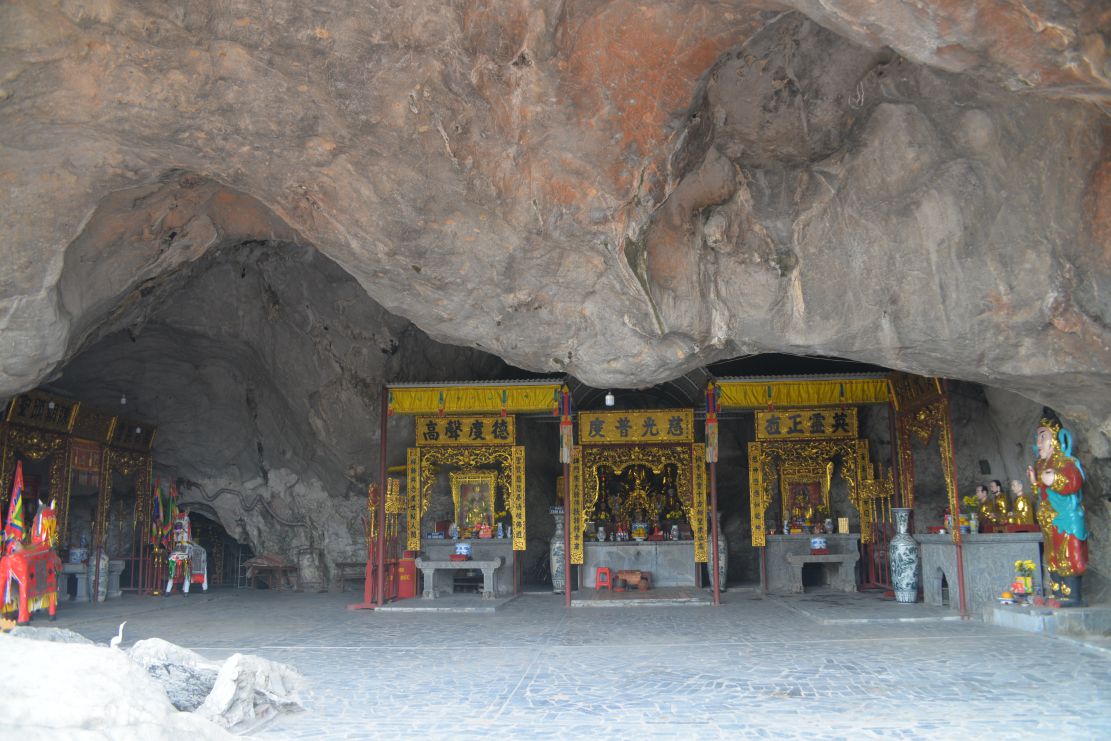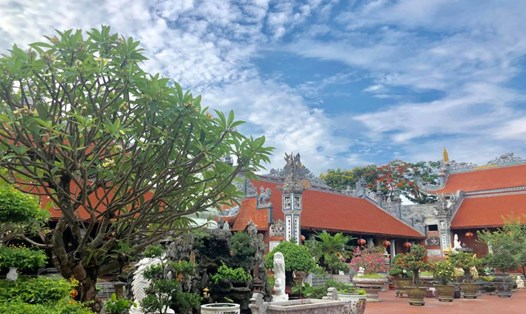The famous majestic victory of Chu Coc Mountain
Son Cave, also known as Chu Coc Cave, is a natural grotto located in the North of the Chu Coc mountain range. Previously, Son Cave was located on Yen Khanh village, Dong Trieu district, Kinh Mon village (now in Phuong Nam ward, Uong Bi city, Quang Ninh province). Son Cave is located along the Da Bac River, in the upstream area of the Bach Dang River, combined with majestic mountain ranges, creating a unique beauty that is rare in nowhere.
Chu Coc Mountain - Son Cave is also mentioned in ancient documents. The book Dai Nam nhat Thong Chi wrote: Nui Chu Coc (Hang Son) is 13 miles north of Thuy Duong District. There is a very sacred temple.
According to legend, the miracle of the god worshiped in Son Cave today has been passed down from generation to generation. The god worshiped in Son Cave is a young man surnamed Pham, a handsome and very intelligent fairy spirit. The young man surnamed Pham learned to read and write profoundly, on the path of astronomy, under the geographical wall, through the path of technology and literature.
During a year, the weather was harsh and there was a dry season, so the young man named Pham used his talent to pray for rain to bring water to help people have a good and healthy crop. Then on the 13th of the 4th lunar month, because he was so tired, the young man transformed into a carp flowing along the Ma River to Son Cave. To commemorate that donation, the local people donated and built a temple in Son Cave and honored it as "Ba Hai Dai Vuong".
Where Hung Dao Vuong ket hop sai tu
A masterpiece of creation, Son Cave is a place of love painting, carrying poetic beauty full of lyrical content. Not only that, this place is also a place to register many historical events, marking important milestones of the nation. In particular, this place is associated with events of resistance against invaders under the Tran Dynasty.
In the third resistance war against the Chinese Mong army (1288), Hung Dao Vuong Tran Quoc Tuan brought troops to this land to ambush the invaders on the battlefield of the Bach Dang River. Before the battle, Hung Dao Vuong entered the temple to burn incense and worship the god of victory in this battle.
After returning from the defeat, Hung Dao Vuong returned to Chu Coc cave to hold a gratitude ceremony and organize a sold out celebration of victory. During that gratitude ceremony, Hung Dao Vuong entered into a brotherhood with Bat Hai Dai Vuong - Duc Thanh Ca Son. During the ceremony, Tran Quoc Tuan scaled wine up the cave wall, over the years, the cave wall became red, from which Chu Coc mountain was also called Son mountain, the cave at the foot of the mountain was called Son cave.
According to historical records, in the first year of Khai Huu (1329), King Tran Hien Tong was on the throne and on a trip to the East. When he arrived at Son cave, he saw a beautiful cave that had the large words "Storm Phuc Nham" engraved on it. Since then, Son Cave has been known as "Storm of Phuc Nham", often appearing in poems and short stories from the Tran, Le and Nguyen Dynasties. That name means beautiful mountain on high mountains that bring many good things.

A place to preserve and promote national cultural values
Not only recorded in different sources of material historical documents and writing. With the majestic beauty of the mountains and rivers donated by nature, Son Cave is also famous for its poems and landscapes.
In the collection " Ly Tran's Poetry volume III", there is also a poem "De Hiep Son Bao Phuc Nham" by poet Pham Su Manh; In the collection "Oc Trai thiet" by national hero, cultural figure Nguyen Trai also recorded the poem "De Bao Phuc Nham"; In the collection " Lu Duong di bo bo thiet" by poet Thai Hoa, there is also a poem "Bao Phuc Nham". The poems all praise the love and affection of this land.
Currently, Son Cave still preserves many stele and ghostwritten documents carved with Chinese and Latino characters (including French and Vietnamese). The content is engraved with important events of Son Cave, restoration, embellishment and merits of the people through the stages. Not only that, on the cave wall, there are 2 Han-language poems about the beauty of Son Cave.
In the large Son Cave, not only the Great Monk and King are worshiped, but the local people also worship the Buddha. Under the Mac Dynasty, according to the stone stele carved in the 7th year of Sung Khang (1572), the names of the person who donated money to restore the temple and carve a Buddha statue are clearly recorded.
Perhaps Son Cave became a place to worship Saints and Buddha from then on. This is also a combination of folk beliefs and Buddhism, imbued with national identity. According to the stele documents carved in the 9th year of Bao Dai (1934), Son cave in Chu Coc mountain was restored and renovated to be larger than before.
Commemorating the diary of the Holy Son cave - who helped the people of this area pray for rain to have a good and healthy crop, every year on the 13th and 14th of the 4th lunar month, the local people organize the festival of the Holy Son cave. The annual festival of the Holy Son Cave attracts a large number of visitors from all over the world to attend and pray for a peaceful and prosperous year.
With its historical and cultural values preserved and the beautiful scenery of nature, the Son Cave relic cluster was recognized by the People's Committee of Quang Ninh province as a historical - cultural and scenic relic in 1999. For tourists who love national culture and beliefs and love nature, want to learn about caves and mountains, Son Cave is a destination not to be missed when visitors set foot in Uong Bi city.










